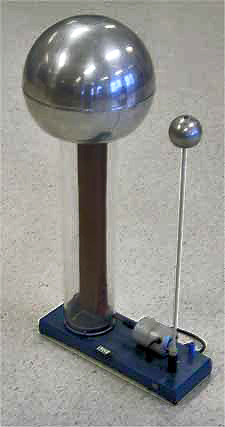Van-de-Graaff-Generator
A Van -de- Graaff generator, also called band generator is an apparatus for generating electrical high DC voltages. The generator was named after the American physicist Robert Van de Graaff, which developed from 1929 band generators.
The Van de Graaff generator is one of the electrical generators and converts mechanical energy into electrical energy, but with very low efficiency. He is next to the Wimshurst and the Tesla transformer, the most commonly used for physical experiments teaching device for high voltage generation. Another application it finds in the Van de Graaff accelerator.
Construction
A surrounding electrically insulating tape, for example a rubber band, which acts as a dark vertical strip is visible in the image, can be electrically charged by friction or by spraying the charge from an external power source. The charge is carried by the movement of the tape inside the large hollow ball visible in the image and then " stripped " by a conducting sphere connected with the brush from the tape. The charge then travels as a result of the field strength at the surface of the sphere and is not transported by the returning band outwards again. The ball can thus be charged to increasingly higher voltage relative to the environment; the voltage is limited only by radio punches at that have become too high field strength.
The visible image in the second, smaller ball is pivotally connected to the base ( ground ) and serves as a counterpoint to the determination of the striking distance of the spark discharge, as well as for the safe discharge of the apparatus. She has for the function of the generator itself no meaning.
Operation
Electric charges are generated on the tape by static electricity ( unwinding of the tape from the lower roller ), or by spraying with a metal comb (peak discharge) from an external voltage source and is transported into the hollow sphere to the latter. There they are delivered via the jetty located in the interior of the ball. It is crucial that the interior of the sphere as a Faraday cage is field-free, so that compensate the electrical forces at each point. Then the transported charges will be issued in its interior light on them, even with large charge on the sphere. The tape is then ready again to accept new charges. By continuing operation of the tape so large amounts of charge can be transported into the ball, resulting in a high electric voltage between the ball and the surrounding area. This voltage difference to be overcome by the charge on the tape in path into the ball. This is achieved by mechanical work is done against the electrostatic attractive force when turning, is between the load and ground potential: the change in the distance results in an increase in voltage on the tape, and the charge can be disposed as electric field energy in the upper sphere. Similar to a charged plate capacitor whose plates are apart from each other (reducing capacity), increases at a constant charge on the tape are the voltage and potential difference to ground:
With
The band is after the return again ready to receive new charges, as the potential decreases again upon return (approximation to the ground ). The work will be disposed of as electric field energy between the upper ball and Environment / Earth.
With continued rotation arises in the large ball, a equilibrium between the charge and the effluent through the air and other ways a charge. Since the charging current mechanically generated is comparatively small, the achievable voltage by the discharge of the weakly conducting air is limited. Therefore, band generators work very poorly in wet climates.
With correspondingly large equipment voltages can be generated by several million volts. The large generators are mostly used for the accelerator incorporated in a pressure tank, which is filled with a suitable, dry gas (e.g., sulfur hexafluoride ).
The ball or at least rounded shape with smooth surfaces minimizes the loss of the cargo, by reducing occurring at sharp edges and peaks caused by field emission predischarges.
Band generators that operate without an external power source, need suitable material combinations (see static electricity ) between the lower pulley and belt to generate enough static electricity in the band when going off of the lower roller.
Externally supplied band generators often have on the tape mutually insulated metal bars, which are loaded on a short distance above the lower roller located a brush or a comb made of metal on top of a discharge. For them, the lower roller must not be made of insulating material. From this, the Pelletron was developed that mutually insulated metal pipe pieces or balls used by insulating chain.
Hazard Statement
For small band generators, the current flowing when approaching the upper ball through the human body discharge is only briefly very high and therefore usually not dangerous. However, band generators are especially a hazard if Leyden jars or other capacitors are loaded with it. The stored energy can then be so high that an electric shock is life threatening.
Photos
Van de Graaff generator without hollow sphere
Upper decrease comb
Lower acceptance comb
Trivia
The British progressive rock band Van der Graaf Generator name from this apparatus.










